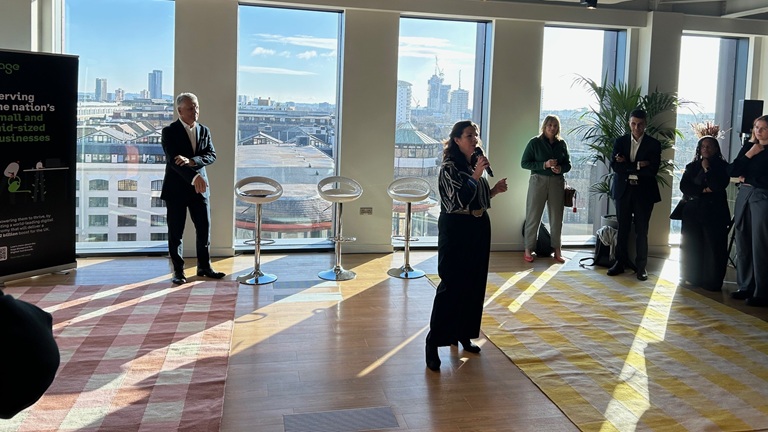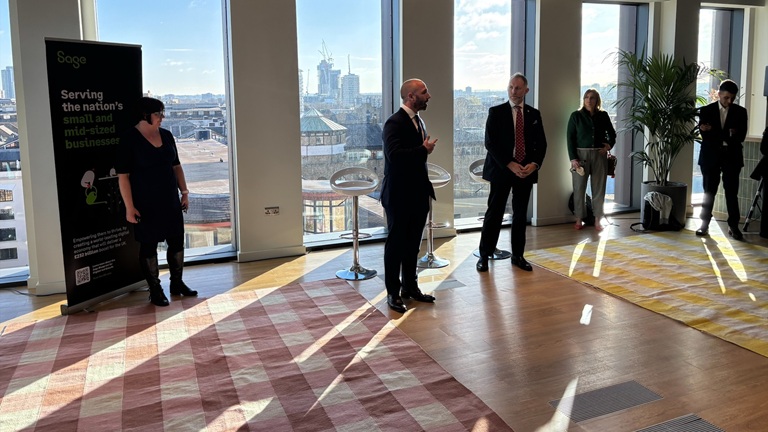Inside the launch of the SME Digital Adoption Taskforce report
)
Posted: Wed 26th Nov 2025
8 min read
Sage's new venue filled with small business owners, accountants, advisers and partners for the public launch of the SME Digital Adoption Taskforce's final report.
If the earlier roundtable focused on turning recommendations into a shared to-do list, the launch event showed what digital change actually looks like in real businesses, told by the people doing it.
Emma Jones CBE: Digital as a route to time, cash and growth
Small Business Commissioner Emma Jones CBE opened the event, setting the scene from both a government and small business perspective.
She highlighted work to tackle late payment, including the Fair Payment Code, and urged firms to sign up so good payers can be recognised.
She linked this to a wider push on open finance and fintech tools that speed up payments and cut the time owners spend chasing invoices.
Her central point was simple: digital tools should help small business owners win more sales and get time back in their week, not add complexity.
Emma pointed to the Department for Business and Trade's collaboration with Google on free AI events and pilots in West Yorkshire and the West of England, designed to understand real barriers to adoption.
She underlined the UK's strength in financial innovation and asked how that capability can be better harnessed for everyday firms, not just those in the Square Mile.
She closed by reflecting on her "inspirational" experience on the Taskforce and introduced its chair, Phil Smith CBE, who she credited with insisting the report stayed practical and actionable.

Phil Smith CBE: Co-ordination, behaviour and belief
Support for SMEs to adopt digital technology, Phil Smith argued, is fragmented.
Government schemes, industry programmes, bank initiatives and local projects all exist, but from a small business perspective they rarely add up to a clear offer.
He called on the government to use its convening power to make the landscape simpler so firms see a coherent journey, not a jumble of brands and websites.
He was equally frank about behaviour. Many owners still don't feel digital tools are "for them". They're busy, often exhausted and wary of change.
Unless solutions feel approachable and deliver immediate, concrete benefits, those owners will keep postponing decisions.
Phil's final theme was belief and trust. The most convincing advocates, he said, aren't technologists or officials but peers.
Business owners are far more likely to act when they hear, in plain language, how someone like them used digital tools to get paid faster, manage staff more easily or win new work.
Storytelling is not an add-on, it's central.
Ravi Shah: A family accountancy firm enters the cloud
Ravi Shah, who runs a family accountancy firm, showed what that looks like in practice.
Before he digitised things, the firm relied on manual processes. Invoices went out late, staff spent hours on repetitive admin and clients had only a sketchy view of their cash position. It worked, but only just.
Ravi moved the practice and its clients onto a digital accounting platform. That meant new software, new workflows and a new mindset.
Some older colleagues were sceptical and nervous about changing systems that "weren't broken". He tackled that by starting small, focusing on "what's in it for you" and making sure each change produced a visible win.
Once the system bedded in, the benefits were obvious.
Routine tasks were automated, freeing up staff members' time.
Clients who embraced cloud accounting saw far better visibility of cash flow, with some improving it by around 30%.
Support from the platform's account managers was key to onboarding and to solving specific clients' problems. As clients did better, so did the practice.
Ravi's message was that digital change rarely comes from one big leap. A series of small, well-supported steps, each clearly linked to value, can transform even a traditional firm.
Steve Morgan and Stephen James: A digital soft landing for veterans
Steve Morgan and Stephen James of Digital Hermes brought a different perspective, of supporting veterans into entrepreneurship.
They described how many ex-forces personnel doubt their skills will transfer to business and feel like "impostors" when faced with tax, regulation and marketing.
Digital Hermes uses tools such as Sage and Xero, web platforms and AI to give those veterans a "soft landing".
That includes:
templates for invoices and proposals,
simple cash flow dashboards
automated reminders that strip out much of the admin
Support from peers is crucial. Veterans trust other veterans.
Hearing from someone who's already made the transition and is using the same tools in their own business makes digital adoption feel like help from a comrade, not a lecture from a stranger.
For Digital Hermes itself, digital tools are the only way a small team can manage a growing caseload.
Its lesson echoed Ravi's – that adoption sticks when it's grounded in a specific community's realities, backed by practical guides and led by recognisable champions.

AI in practice and what SMEs say they need
Across the session, AI was presented as a practical helper, not a distant technology. Speakers pointed to:
tools that transcribe and summarise meetings
services that cut long videos into short clips for social media
AI assistants that help draft routine documents
None of this replaces human judgement, but it removes tedious work and helps people get started.
Owners in the room were clear about what helps them move:
Short, practical guides and clear "start here, do this next" journeys, instead of dense manuals
Longer, low-risk trials with proper onboarding, rather than brief demos
Support from trusted accountants, bookkeepers and advisers who understand both the tech and the business model
Government processes that remove rather than add friction (for example, by cutting unnecessary checks and form-filling)
Where policy and industry go next
The launch event brought the Taskforce's recommendations to life.
For policymakers, the strongest message was to simplify – join up programmes, streamline regulation and procurement and fix the government's own digital processes so they support, not undermine, productivity.
For industry, especially software providers, the challenge is to design onboarding and support that reflects how real small businesses work, and to work through the intermediaries those businesses already trust.
People also read
What it'll take to get more SMEs adopting technology in 2026
The case for a national CTO-as-a-service programme – and why it matters
How government and businesses can partner to drive small business adoption of AI
Make your small business more secure with the free Tech Hub tool
Get tailored recommendations, join virtual workshops, connect with expert advisers and find practical resources. Take me to Tech Hub now
Get business support right to your inbox
Subscribe to our newsletter to receive business tips, learn about new funding programmes, join upcoming events, take e-learning courses, and more.
Start your business journey today
Take the first step to successfully starting and growing your business.
Join for free

